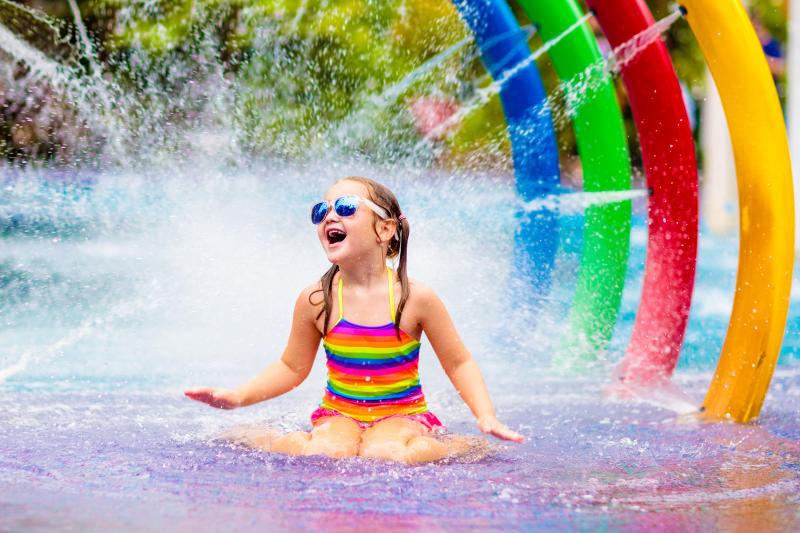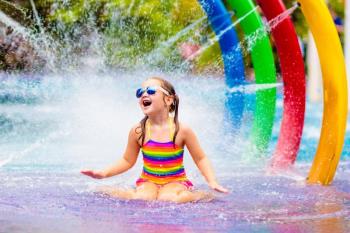Outdoor amusement businesses must do this to reopen
AUGUSTA — The checklists for businesses falling under Phase 3 of Maine’s reopening plans have been released.
The following is what outdoor entertainment and amusement businesses, such as water and amusement parks, must do to reopen amid the COVID-19 pandemic.
Phase 3: Outdoor Amusement
Outdoor entertainment and amusement venues bring people from different households into close contact with each other and have the potential to increase COVID-19 transmission. The primary tools to control the spread of COVID-19 are to reduce exposure to respiratory droplets through physical distancing and face coverings, increase hand hygiene, and avoid shared items and common touch surfaces. The goals of this guidance are to protect employees, guests, and the local community from COVID-19 infection.
General Guidance
- Require all employees, vendors, and guests to maintain 6 feet of physical distance from individuals who are not part of their household group whenever possible.
- Require all employees, vendors, and guests to wear a face covering when physical distancing is difficult to maintain, per CDC recommendations and pertinent Executive Orders from the Office of the Governor. It is strongly recommended to wear face coverings even when physically distanced.
- Because interacting with more people raises your risk, employees who interact directly with guests (e.g. ride operators, ticket takers) are encouraged to wear a face shield, in addition to a face covering. It is acceptable for employees to wear a face shield in lieu of a face covering if they must work in warm weather for prolonged periods.
- Face coverings do not need to be worn while an individual is eating or drinking.
- Additional information about proper use of face coverings is available from the CDC (see: Use of Cloth Face Coverings to Help Slow the Spread of COVID-19).
- The number of individuals that can gather in a shared space must not exceed the limit established by the Governor’s Executive Order, currently set at 50 people.
- A shared space, for the purpose of an outdoor amusement establishment, means one contained area with a controlled entrance and exit.
- If a space cannot accommodate the gathering limit without complying with the six-foot distancing requirement, occupancy in that space must be limited to allow for such compliance.
- Total occupancy across the distinct areas of an outdoor venue should not exceed 25% of regular occupancy.
Cleaning and Disinfection
- Refer to the following documents for guidance on general cleaning and disinfection:
Staff
- Staff should consider whether they can work safely if they have any of these conditions and managers should discuss potential risks for individuals with the following:
- People 65 or older
- People who live in a nursing home or long-term care facility
- People of all ages with underlying medical conditions, particularly if not well controlled including:
- People with chronic lung disease or moderate to severe asthma
- People who have serious heart conditions
- People who are immunocompromised: Many conditions can cause a person to be immunocompromised, including cancer treatment, smoking, bone marrow or organ transplantation, immune deficiencies, poorly controlled HIV or AIDS, and prolonged use of corticosteroids and other immune weakening medications
- People with severe obesity (body mass index [BMI] of 40 or higher)
- People with diabetes
- People with chronic kidney disease undergoing dialysis
- People with liver disease
- Staff should stay at home if they are sick. Supervisors should ask all staff to self-screen for COVID-19 symptoms using either of the following approaches:
- Use an electronic or app-based self-screening form, such as the Coronavirus Self-Checker available on the federal CDC’s homepage.
- Self-screen using the following questions:
- Do you feel ill or have you been caring for someone who is ill?
- In the past two weeks, have you been exposed to anyone who tested positive for COVID-19?
- Require employees to practice good hand hygiene with frequent handwashing, especially after contact with other individuals or high-touch surfaces.
- Conduct business by phone or internet to the greatest extent practicable.
- Limit in-person gatherings or meetings of employees to the greatest extent practicable.
- Where possible, stagger employee shifts and meal breaks to avoid crowding.
- Adjust seating in break rooms and other common areas to promote physical distancing practices.
- Permit employees to take breaks and lunch outside, or in such other areas where physical distancing is attainable.
- Discourage employees from using colleagues’ phones, desks, workstations, radios, handhelds/wearables, or other office tools and equipment.
- Limit interactions between employees and outside vendors or delivery drivers; implement touchless receiving practices if possible.
- Request that vendors accessing the premises direct their employees to follow all physical distancing guidelines and health directives issued by the applicable public authorities.
- Adjust training/onboarding practices to limit number of people involved and allow for 6 foot spacing; use virtual/video/audio training when possible.
- Provide employees training on:
- hand hygiene
- physical distancing guidelines and expectations
- monitoring personal health
- proper wear, removal, and disposal of Personal Protective Equipment (PPE)
- laundering of face coverings and uniforms: Cleaning and Disinfecting Your Facility, How to Disinfect: Laundry (CDC)
- cleaning protocols, including how to safely and effectively use cleaning supplies: Guidance for Cleaning and Disinfecting Public Spaces, Workplaces, Businesses, Schools and Homes (CDC)
- Consider employee training in safe de-escalation techniques.
Communicating COVID-19 Policies
- Inform guests of your COVID-19 policies and procedures in advance, if possible, via website, newsletters, social media channels, newspaper, ticket purchasing site, etc.
- Place signage at entrances and throughout venue (particularly high traffic areas such as service counters and queuing areas, as well as back of the house areas) alerting employees and guests to required occupancy limits, physical distancing requirements, face covering policies, symptoms of COVID-19, and other health and hygiene reminders. The federal CDC has developed free, printable posters on these topics (see: Print Resources).
- It is strongly recommended that businesses remind patrons that if they are ill (e.g. have a fever or cough) they should not visit. Signage reminding patrons of the signs and symptoms of COVID-19 is highly recommended.
- Consider using announcements and/or recorded messages to communicate COVID-19 policies to guests during their time at the venue.
Operational Considerations
- Ensure that staffing is sufficient to enable enhanced cleaning and disinfection measures and enforcement of new safety guidelines.
- Ensure adequate supplies (e.g., soap, paper towels, hand sanitizer, tissue) to support healthy hygiene practices, including increased cleaning and disinfection procedures.
- Take steps to improve ventilation in any buildings on the premises.
- Increase the percentage of outdoor air (e.g., using economizer modes of HVAC operations) potentially as high as 100% (first verify compatibility with HVAC system capabilities for both temperature and humidity control as well as compatibility with outdoor/indoor air quality considerations).
- Increase total airflow supply to occupied spaces, if possible.
- Disable demand-control ventilation (DCV) controls that reduce air supply based on temperature or occupancy.
- Consider using natural ventilation (i.e., opening windows if possible and safe to do so) to increase outdoor air dilution of indoor air when environmental conditions and building requirements allow.
- Take steps to ensure that all water systems and features (for example, drinking fountains) are safe to use after a prolonged facility shutdown to minimize the risk of disease. Further guidance is available from the CDC (see: Guidance for Reopening Buildings After Prolonged Shutdown or Reduced Operation).
- Consider restricting the use of water fountains to refill only with instruction for employees and guests to wash or sanitize hands after use.
- Consider installing non-porous physical barriers such as partitions or plexiglass barriers to protect employees and guests. Barriers should be placed at information desks, service counters, and other similar locations where it is not possible to maintain a minimum of 6 feet of physical distance.
- Limit activities that require individuals to enter within 6 feet of another person, regardless of whether physical barriers are installed.
- Modify building/venue traffic flow to minimize contact between employees, vendors, and guests. Use floor decals and/or signage to establish travel patterns.
- Consider one-way entrances and exits, if possible.
- Consider establishing one-way travel patterns through the venue.
- Minimize traffic in enclosed spaces, such as stairwells and other spaces that do not allow for appropriate physical distancing. Consider limiting the number of individuals in an elevator at one time and designating one directional stairwells.
- Ensure your First Aid protocols address how to manage guests or employees with COVID-19 symptoms. If an individual becomes ill at your venue have a plan for a room or space where the person can be isolated until transferred to home or health care facility and provide a face covering or mask, if available and tolerated.
- For contact tracing purposes, to the extent practicable, establishments should maintain a record including contact information for employees and guests who have direct prolonged interaction.
- Based on current knowledge, a close contact is someone who was within 6 feet of an infected person for at least 15 minutes starting from 48 hours before illness onset until the time the patient is isolated. Close contacts should stay home, maintain social distancing, and self-monitor until 14 days from the last date of exposure.
- Establishments should promptly notify the Maine DHHS, CDC or any local health official if a they learn an employee or other worker has tested positive for COVID-19 and assist all such officials as reasonably requested to trace likely contacts and advise contacts to isolate and self-quarantine.
- Food and beverage operations should follow state guidance on safe operation of restaurants.
- Drink or food refills should not be allowed unless served in a clean unused container.
- Minimize self-service areas such as drink stations. To the extent possible, use contact-less dispensers to minimize hand touching. Replace multi-use condiments with single-serve packets. Other suggestions to minimize multi-touch surfaces include providing single-wrap utensils, straws, and lids at any take-out or self-seating point of sale. Any self-service areas require frequent cleaning and disinfection
- Use of prepackaged food and beverages is encouraged.
- Consider where lines may form around food service operations and implement the guidance described in the “Arrival and Queuing Areas” section of this guidance.
- Retail spaces should follow state guidance on safe operation of retail businesses.
- Minimize shared touch surfaces such as pens, tablets, receipts, etc.
- High-contact areas such as doorknobs and counters should be cleaned frequently.
- Attractions utilizing shared equipment (e.g. controls/handles, harnesses, seats) should be cleaned and disinfected frequently.
- Guest touch locations such as kiosks, interactive displays, and video/arcade games should be cleaned and disinfected frequently. Consider providing sanitizing wipes or hand sanitizer near these locations.
- Rides or amusements that cannot be cleaned and disinfected frequently are discouraged.
- Amusements with seating should maintain a minimum of 6 feet between household groups. Non-compliant benches, booths, seats, and machines should be physically marked with tape, signage, or barriers to prevent use.
- Evaluate locker/personal storage arrangements. Close or rotate sections to allow for appropriate physical distancing. Consider positioning an employee in the locker/storage area to limit the number of people in the space at one time. Clean and disinfect locker areas frequently.
Restrooms
- Limit restroom occupancy for group restrooms to incorporate physical distancing and avoid formation of waiting lines outside of restrooms.
- Clean and disinfect restrooms on a regular and scheduled basis (see General Cleaning and Disinfecting section).
- Remove any items that do not have to be in the restrooms (e.g., magazines, decor).
- Consider establishing separate restrooms for employees and guests.
- Post handwashing signs in all restrooms. The federal CDC has developed free, printable posters that describe appropriate handwashing standards (see: Print Resources).
Arrival and Queuing Areas
- Eliminate waiting lines to the greatest extent practicable. Where lines are unavoidable, ensure 6 feet of distance between individuals. This can be accomplished by demarcating 6-foot distances on floors or walls. When developing your plan for managing waiting lines, consider the various locations were lines may form, including entrances and exits, waiting areas for amusement rides and attractions, food and beverage operations, and restrooms.
- Eliminate “zig-zag” queue patterns that make physical distance difficult to maintain.
- If an ingress queue consistent with physical distancing would cause the line to extend into a road or pedestrian walkway, consult with local public safety authorities to determine where to safely queue patrons.
- To the extent practicable, alter security protocols to allow for compliance with physical distancing, proper hand hygiene, and cleaning and disinfection practices.
- If bag checks are part of an establishment’s security protocols, avoid touching patron personal items. Consider enforcing a small clear bag policy in which patrons open their own bags for inspection. Alternatively, consider prohibiting bags entirely, although exceptions will likely be necessary for medicine or personal hygiene products.
- Walk-through magnetometers are effective at detecting metallic objects while allowing security workers to maintain social distance. Hand wands are a less costly alternative that still allow no-contact metal detection, but they require the security worker to be closer than six feet from the patron, so they are less optimal from a health perspective. Pat-downs present the highest risk for transmission, and venues may deny admission to patrons who repeatedly activate the magnetometer rather than putting hands on patrons. It is strongly recommended that any worker conducting a pat-down search wear a face covering, face shield, and gloves and have access to a wash and hand sanitizing station.
Ticketing and Other Transactions
- Utilize remote ticketing/payment options to reduce transactions on site and manage congestion.
- Use digital rather than paper formats to the greatest extent practicable (e.g. electronic tickets, maps).
- Where possible, stagger arrival times to minimize queue lines or crowds at the attraction entrance. Consider a timed ticking program that staggers arrivals.
- Consider offering all-inclusive package deals to reduce transactions on site.
- Limit cash and paper receipt transactions; Promote “contactless” payment options (e.g., online payments, pay by phone options, RFID credit and debit cards, Apple Pay, Google Pay, etc.)
- Wash hands or use alcohol based hand sanitizer (at least 60% alcohol) after handling cash.
- Where possible, card readers should be placed in front of physical barriers so guests can swipe their own cards and enter their codes. Card readers and keypads should be cleaned and disinfected frequently. Hand sanitizer should be made available for guests before and after transactions.
- Discontinue the use of equipment lent to visitors unless they can be properly cleaned and disinfected after each use.
Rides, Attractions, and Exhibits
- It may not be possible to open some attractions if compliance with 6-foot distancing requirements and/or cleaning and disinfection requirements cannot be implemented or upheld.
- Evaluate the speed and other dynamics of each attraction to determine if face coverings of various types (e.g. common surgical masks with loops around the ears, fabric face coverings with ties around the head) can be safely worn and secured on rides. Face coverings should not present a loose-article hazard or interfere with the safe operation of the attraction.
- Reduce the number of guests per ride vehicle to facilitate physical distancing between riders of different household groups. This may be accomplished by requiring empty rows and/or seats between riders. Remain cognizant of the need to balance the ride, if required by the ride manufacturer.
- To ensure compliance with physically distanced loading and seating arrangement, ride operators or attendants are encouraged to assign seats to riders. Develop a method to count and pre-group the appropriate number of riders for a ride cycle.
- Provide hand sanitizer stations with guidance for visitors to sanitize before and after going on rides.
- Clean and disinfect of high-touch surfaces on rides and attractions.
- Frequently clean and disinfect to the extent possible ride surfaces touched by guests or employees, including handrails, armrests, restraints, lap bars, grips, seatbelt, harnesses, ride storage areas for guests’ personal belongings, etc. Encourage guests to use hand sanitizer before and after rides.
- Cleaning and disinfection approaches should be based on the guidelines provided on the cleaning chemicals and the surface being cleaned (see Cleaning and Disinfection section of this guidance).
- Make sure rides are secured (including safety lockouts as needed) so employees can safely access the areas they need to clean.
- Clean and disinfect control and dispatch panels between each employee rotation.
- Consider refining height check operations to make them touch-free and easy to manage/view from a few feet away (e.g., highly visible height markers, an elevated bar for guests to stand under). If a venue includes attractions with age, weight and/or height requirements, consider developing a system for issuing a credential such as a wristband or bracelet to verify eligibility to ride certain categories of rides.
- Follow manufacturer guidelines/standard operating protocols to ensure restraints are locked, seatbelts are fastened, and riders are properly secured. The guests and employees should wear face coverings during the process as long as the face coverings do not interfere with the safe operation of the ride.
- As a general rule, employees should avoid physical contact with guests.
- Person-to-person contact while providing loading and unloading assistance raises the risk of transmission. If a guest needs assistance, employees should ask one of the guest’s household members to provide the assistance, if possible. In the event an employee must assist a guest, the employee should offer a shoulder or an elbow for stability assistance. Employees and guests should wash or sanitize hands after interaction.
- If children cannot load or unload a ride on their own, ride operators may ask a guardian to assist with loading/unloading.
- For walk-through attractions:
- Monitor entrance and venue capacity carefully to ensure guests can maintain physical distancing within the space.
- Consider implementing a one-way traffic flow though the space.
- Carefully evaluate attractions that require personal harnessing like ropes courses, climbing walls, and steel-cable swing rides because of the difficulty maintaining physical distancing during the harnessing process. The increased cleaning and sanitizing of the harnesses and other equipment between each use may also be difficult and time consuming.
Entertainment, Shows, and Animal Experiences
- Refer to the checklist for Performing Arts Venues for guidance on safely managing entertainment venues on your premises.
- Structure animal feeding/interaction experiences to manage physical distancing in those environments.
- Review/reconsider procedures for close contact meet-and-greet interactions with face characters, costume characters, or animals. Be sure to address physical distancing requirements. Consider “drive-by” character experiences in vehicles or appearances on stages to provide visibility from a distance.
- Review procedures and policies for cleaning and disinfection of costumes, wigs, and props to ensure alignment with CDC guidelines (see: Cleaning and Disinfecting Your Facility, How to Disinfect)
Water Parks
- While there is no evidence that COVID-19 can be spread through water, steps must be taken to reduce the risk of person-to-person transmission by maintaining a physical distance of at least 6 feet from others when in pools or similar areas. Consider not opening an attraction if physical distancing cannot be managed effectively for that attraction.
- Guests should wear face coverings whenever possible, including in common areas, near other guests, and when interacting with employees. Whether guests should wear face coverings on water park attractions depends on the attraction. Operators should assess with their lifeguard company or the ride manufacturer to determine the appropriate guidelines. Face coverings should not present a loose-article hazard, interfere with the safe operation of the attraction, or present a concern on attractions where guests are or may be fully immersed in water. When a face covering becomes wet or soiled, it should be changed.
- Evaluate seating/lounging areas and adjust them to accommodate physical distancing.
- In pools, wave pools, and water play/splash pads, manage entry and remind guests to stay 6 feet apart from individuals who are not part of their household group.
- In lazy rivers or other similar attractions, manage entry to maintain reduced capacity that allows for physical distancing. Remind guests to stay 6 feet apart from individuals who are not part of their household groups.
- If a raft or other ride vehicle accommodates more than one guest, that vehicle should only carry members of the same household group.
- If a high-touch surface is not covered in chlorinated pool water, it should be cleaned and disinfected frequently.
- For any pool, adequate disinfection will inactivate coronavirus, so careful attention must be paid to ensure that the pool has adequate disinfectant, proper Oxidation-Reduction Potential (ORP) values in pools where that value is measured, and proper recirculation.
- Clean and disinfect life jackets between uses following manufacturer cleaning guidance and waiting time period between uses. Encourage patrons to bring their own life jackets if appropriate with facility safety policies.
- For guidance on laundering towels, refer to guidance from the federal CDC (see: Cleaning and Disinfecting Your Facility, How to Disinfect: Laundry).
- If possible, equipment should not be shared between lifeguards. If sharing must occur, rescue tubes and dispatch panels should be cleaned and disinfected at each lifeguard rotation.
- High-touch surfaces on lifeguard stands (handrails, ladders, arm rests, etc.) should be cleaned and disinfected between lifeguard rotations.
- Evaluate locker arrangements. Close or rotate sections to allow for appropriate physical distancing. Consider positioning an employee in the locker area to limit the number of people in the space at one time. Clean and disinfect locker areas frequently.
- Consider closing attractions and activities at different times in stages to avoid crowding at lockers, in changing rooms, and at exits.
Event Date
Address
United States

























